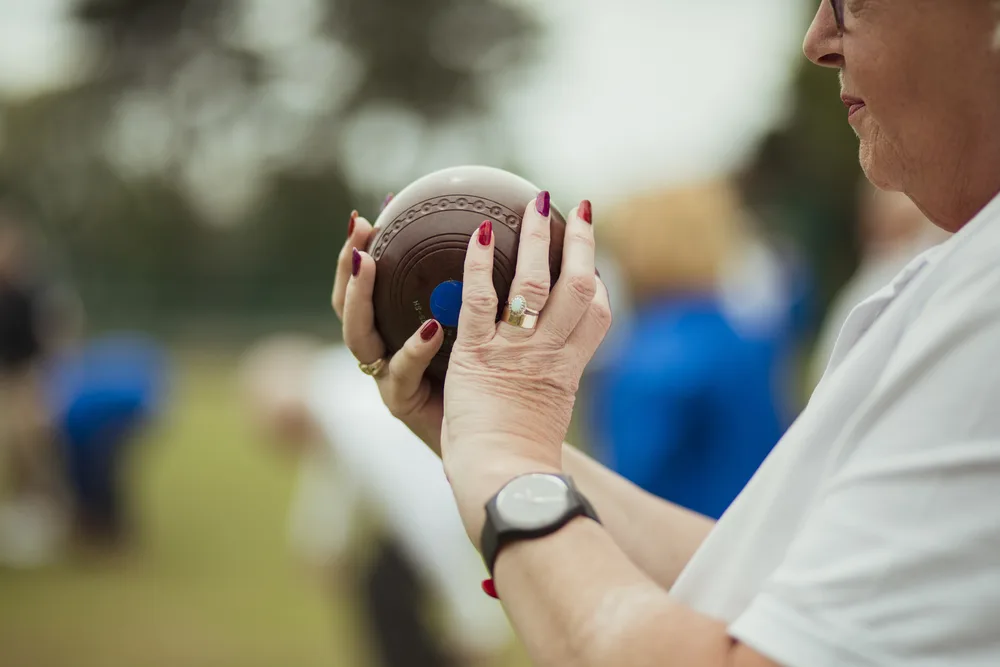
Lawn bowling is much more than rolling a ball towards a target. Just like every other game, it has a distinct set of rules players must abide by during play. These rules cover how the game should be played, what’s allowed, what’s prohibited, and more.
So, if you’re thinking about giving the game a shot, it only makes sense to read this article all the way to the end. In it, we’ll share the lawn bowling rules you need to know as a beginner.
Contents
Basic Lawn Bowling Rules
We assume that since you happened upon this article, you already have some idea of what lawn bowling is. But just in case you don’t, lawn bowling (also called lawn bowls) is a bowling variation that’s similar to Bocce and very different from regular ten-pin bowling. It involves rolling biased (not perfectly round) balls across a flat lawn, known as flat green bowls, with the objective of getting them as close to the target as possible.
The bowls always travel on a curved path instead of a straight line, which means that players must craft strategies to get the results they want. This seems simple enough, but there are several rules that give the game structure and make it more fun for both casual and competitive play.
Before we get into the most specific lawn bowls rules, it’s essential to go over the basics. That way, you won’t feel lost as we progress. Here are the basic rules of lawn bowling for beginners:
Setting Up, Deciding Play Order, and Gathering Equipment
Lawn bowling setup is a multi-step process. It may seem like a lot at first, but you’ll get the hang of it the more you play. Here’s what you need to do:
Find a Spot to Play
Lawn bowling should be played on a bowling green, which is a flat, grassy playing surface that takes on the shape of a rectangle. If you’re at a lawn bowling club, all you’ll need to do is choose a rink.
There are variations of lawn bowling that you may come across as you explore the sport – Crown Green Bowls, for example. It’s similar to regular lawn bowls, but instead of playing on a flat surface, you’ll play on a field with a raised surface in the center.
Decide on Play Structure
You can play with as few as 2 people or as many as 8 players in teams. There are four variations in this regard:
- Singles
- Pairs
- Triples
- Fours
The number of bowls played per end (round) depends on the number of players in the game. For singles and doubles matches, each player will roll four bowls. In triples matches, players will roll three bowls. And in fours matches, you’ll roll two bowls each.
Get Your Equipment
After you figure out the play structure, you’ll need to get your hands on the right equipment. Here’s what you’ll need:
- A set of bowls (balls) for each player (Every player should use the same set to ensure the game is fair )
- A coin for flipping or some other means to decide who goes first
- A small white ball (jack)
- Flat shoes
- A foot mat
- Measuring tool
- Chalk or Chalk Spray
With your equipment in hand and everything else decided, you’re ready to move to the next step.
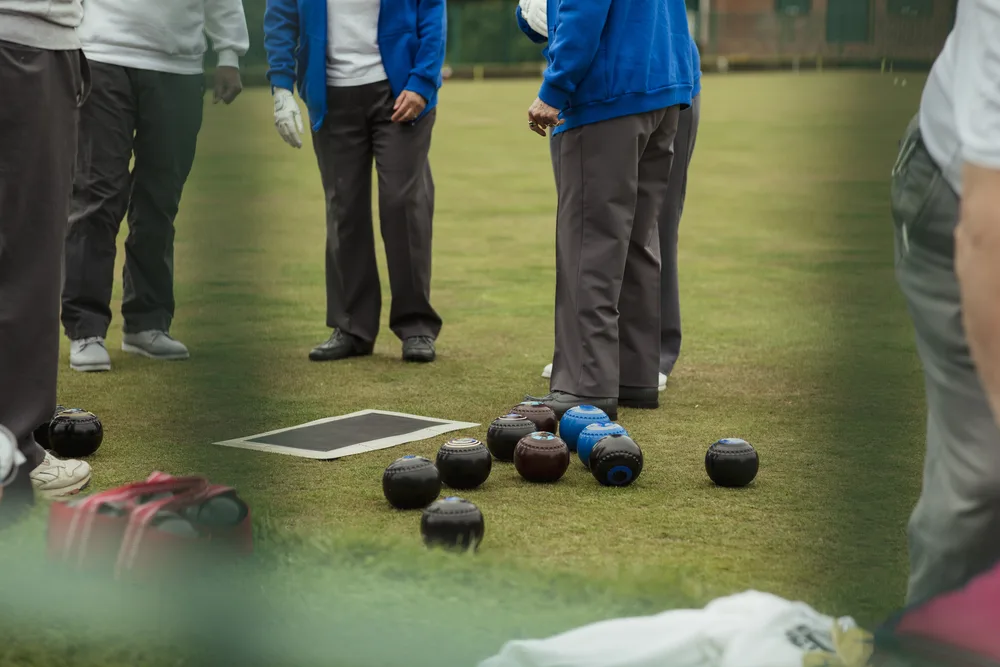
Decide Game Length
Before you move forward, you’ll need to decide on the game’s length. You may decide on a time limit (1, 2, or 3-hour game), a specific number of points (shots), or a maximum number of ends (rounds). Generally, Lawn Bowl is played over 18 or 21 ends in formal competitions. This should be decided beforehand so there are no issues later.
Starting the Game: Setting the Mat and Rolling the Jack
There are also rules about how to start a game. In most cases, you’ll start with a coin flip to determine who will go first. Whoever wins the coin toss has to make a decision. They can make one of two choices:
- They will go first.
- The other team will go first.
Whoever is designated to be first will do two different things. First, they’ll place the mat, and then they’ll deliver the jack. Here are the rules to follow for both of these steps:
- The mat should be placed in line with the rink markers on the bowling green. If you don’t have rink markers, you can take a couple of measurements yourself. The mat should sit on the center line at least 2 meters (6.56 feet) away from the back ditch and 25 meters (82.02 feet) from the front ditch.
- To deliver the jack according to official rules, it should be delivered, allowed to come to a full stop, and then centered. The delivery doesn’t count if it ends up outside the rink’s boundaries, in a ditch, less than 23 meters (75.46 feet) from the mat, or contacts the face of the bank or a person or object outside the rink.
Delivery of the Bowls
Now that the jack is in place, it’s a target for both individuals or teams. To continue the game past this point, each team or individual will roll their bowls. They’ll try to get the bowl as close to the jack as possible. Once one player rolls, a player from the other team will roll.
After every player from both teams rolls, that’s the end of the round (called an end). Play will take place in the opposite direction for the next end. That means the players will target the jack from the other direction. Players should play in the same order throughout the whole game.
Other Lawn Bowling Rules You Need to Know
The above rules are a lot to digest, but they aren’t the only rules you need to know about to play the game legitimately. Here are a few other lawn bowling rules beginners should be familiar with.
Mark the Toucher
In lawn bowls, a toucher is a bowl that, in its original course, touches the jack before the next bowl is delivered. Touchers have special significance because they remain live bowls even if they end up in the ditch (the area surrounding the rink), provided the jack is still in play on the rink. Non-toucher bowls that end up in the ditch are considered dead and are removed from play.
To signify a toucher, mark the bowl with chalk immediately after it comes to rest and before the next bowl is delivered. The marker, who could be a player or an umpire, typically uses a piece of chalk or a chalk spray to make a small mark on the bowl. This chalk mark signals to all players that the bowl is a toucher.
If a potential toucher is not marked before the next bowl is delivered, it loses its toucher status. The responsibility for marking touchers typically falls on the player who delivered the bowl or their team or on the marker in a singles match.
The rules around touchers and their marking can vary slightly between different lawn bowling clubs and associations, so it’s always a good idea to become familiar with the specific rules of the place where you’re playing.
Where to Stand During Play
It’s important to know where you should be during gameplay. If you’re not the one who’ll be throwing a bowl, you should be on the opposite side of the rink behind the jack. If the jack is in a ditch, those who aren’t throwing a bowl should stand on the surrounds of the green.
It’s very important to stay away from other rinks where people are playing so as not to disturb them. Not only is this proper etiquette, but it also helps maintain a calm and focused atmosphere for all players. Lawn Bowls is a game that requires precision and concentration, and unnecessary disturbances can significantly affect a player’s performance.
Displaying proper etiquette is as important in lawn bowling as it is in other types of bowling.
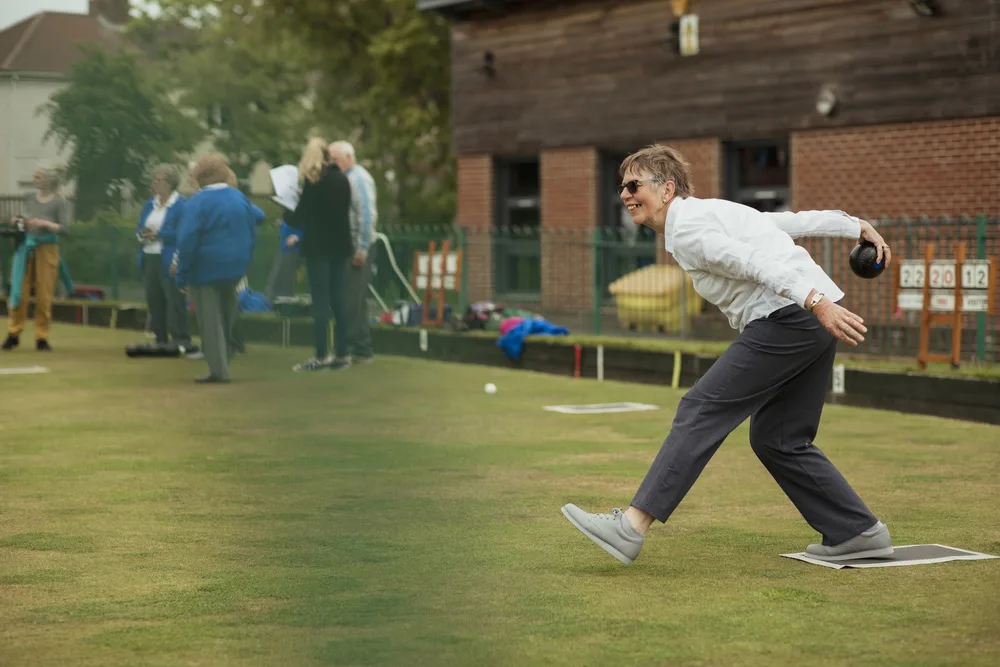
Make Sure the Mat Doesn’t Move Around
To ensure a fair game, it’s important that the mat doesn’t shift around. Each player should be delivering the bowl from the exact same spot. So, if the mat ever moves from its initial position, take the time to move it back.
Ensuring the mat stays put isn’t just about fairness but also about preserving the strategic aspects of the game. Players make decisions based on the current state of play, including the position of the mat. If the mat moves, it can invalidate those strategies, disrupting the flow and tactical nature of the game.
Know What Constitutes a Dead Bowl
In lawn bowls, a bowl is considered “dead” if it comes to rest outside the boundaries of the rink, which includes landing in the ditch without first having touched the jack (which would make it a toucher). Additionally, if, during its course, a bowl is knocked out of the rink or displaced from the rink by another bowl, it’s also considered “dead.”
Dead bowls are removed from play and do not count toward the scoring for that end. The specific rules for when and how bowls are declared dead can vary slightly between different clubs and associations, so keep that in mind.
In some cases, if a delivered bowl doesn’t travel at least 14-20 meters (45.93-65.62 feet)(depending on the specific rules of the competition), it could also be considered a “dead” bowl. This minimum distance rule is designed to ensure a certain level of skill in delivering the bowls.
When to Calculate Shots
In lawn bowls, shots are calculated at the conclusion of each “end.” An end is completed when all players or teams have thrown all of their bowls. At this point, the players or teams will determine the score for that end.
It’s important to wait until all bowls have been thrown before determining the score, as the position of the bowls (and, therefore, the score) can change with each throw. Also, players should avoid moving any bowls until the score has been agreed upon to ensure an accurate count.
All the bowls are then collected, and the next end begins. The game continues in this way, with the total score being calculated at the end of the predetermined number of ends.
What Counts as a Tie
Ties come up in lawn bowling from time to time. And there are two potential tie types; here’s a rundown of both.
Tie Game
A tie game, also known as a draw, occurs when both teams or players have the same score at the end of the game after all ends have been completed. If a tie occurs, the match may be declared a draw, with each side receiving equal points in a league situation.
However, in some tournaments or championship games where a winner must be decided, an extra end or series of ends may be played to break the tie, similar to overtime in other sports. This is often referred to as a “tiebreaker.” The team or player that scores the highest in this extra end(s) is declared the winner.
Tied End
If the closest bowl of each team or player is equidistant from the jack, no points are scored for that particular end in most cases. Essentially, the end is considered tied, and the game moves on to the next end.
In a very competitive match or in certain tournaments, officials might use precise measuring tools to determine which bowl is truly closer, as it can sometimes be hard to judge by eye alone.
Note: There are other rules that may apply in the above situations; feel free to reference the official rules for more information.

Playing Out of Turn
Playing out of turn-in lawn bowls can disrupt the flow of the game. The specific consequences can vary based on the particular rules of the competition or club.
In some instances, if a player delivers a bowl out of turn, the opposing team or player may have the option to stop the bowl in its course and have it re-played in the correct order. Alternatively, they may choose to leave everything as it is and just continue playing.
In other cases, the bowl delivered out of turn might be considered “dead” and removed from play for that end.
In most friendly games or social bowls, an honest mistake of playing out of turn is usually simply corrected without penalty. In a more competitive match, players are expected to know the order of play and stick to it, so the penalties could be stricter.
Changing Bowls
The general rule in lawn bowls is that a player must use the same set of bowls for the entirety of a game. Switching bowls mid-game could potentially create an unfair advantage, as different bowls may have different biases or characteristics that could be used strategically depending on the state of the game.
If a player changes a bowl mid-game without a valid reason (for example, in the case of a damaged bowl), it is typically considered a breach of the rules. The exact penalties for this can vary depending on the specific rules of the competition or club. Penalties could include forfeiting the game, losing points, or other sanctions.
In the event of a bowl becoming damaged or unusable during the course of a game, the laws of the sport allow a player to replace the damaged bowl with another bowl, with the approval of the umpire or the other player or team.
How Do You Score in Lawn Bowls?
A player scores when they roll a bowl closer to the jack than the opponent’s nearest bowl. In a singles match, a person will receive one point if they roll their bowl closer to the jack than their opponent. In team matches, the score is decided once per end (round).
In a triples match, if one team rolls two bowls closer to the jack than the other team, they’ll get two points added to their score. Since it can be difficult to tell whether one bowl is closer to the jack than another, taking measurements is part of the game. To do so, you’ll use a measure, a specialized tool created especially for this purpose.
How Many Games Are in a Lawn Bowl?
In lawn bowling, a series of games can be referred to as a “tournament” or a “league,” depending on the structure of play. A “tournament” usually refers to a competition involving a relatively large number of competitors. The structure of tournaments can vary widely but often involves knockout stages, where the loser of a match is immediately eliminated from the tournament, eventually resulting in a final match to decide the winner.
A “league” is a series of games usually played by a set group of teams or individuals over a season, with a schedule determined by the organizer. The competitors may play each other multiple times, and the winner of the league is often the team or individual with the most points or wins at the end of the season.
It’s important to note that the terminology can differ between regions and organizations, so it’s always a good idea to check the specific rules of the competition in question.
Frequently Asked Questions
How do you play lawn bowling?
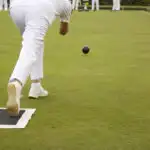
Get the big ball closest to the little ball.
Ok, it’s not that simple, but that’s the jest of the game.
Using a biased bowl, the goal is to get it closest to the jack. After all the bowlers have delivered their bowls, the team with the most points wins. Here’s a deeper explanation of lawn bowing here.
What is lawn bowling etiquette?
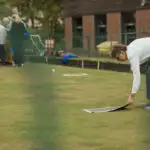
Lawn bowling etiquette refers to the set of unwritten rules and guidelines that players are expected to follow while participating in a game of lawn bowling. These rules are designed to ensure fair play, respect for opponents and teammates, and a pleasant atmosphere on the bowling green.
Where do you aim in lawn bowls?

5 points to aim for are a point on the green, Jack’s position, the opponent’s bowls, visual markers, or the path of previous bowls.
You aim to deliver your bowl in a way that strategically places it close to the jack while also considering the positioning of the opponent’s bowls and the overall game situation.
Aiming Point on the Green: This is the most critical point to focus on. Choose a spot on the green where you want your bowl to land or pass over. This point is usually in line with your intended delivery line and the direction you want the bowl to take. It could be the jack itself, a specific position on the green, or a point that will lead your bowl to the desired target.
Jack Position: Keep an eye on the jack’s location, especially if you’re aiming to get close to it. You’ll want to consider its position as you choose your aiming point and delivery line.
Opponent Bowls: Take note of where your opponents’ bowls are positioned, as this can help you strategize your shot. If their bowls are close to the jack, you might aim to displace or move them while getting closer to the jack.
Visual Markers: On many greens, there might be markers or reference points that can help you aim accurately. These markers could include lines, spots, or patterns on the green that indicate certain distances or directions.
Path of Previous Bowls: If you’re not the first to bowl in a round, observe how previous bowls have behaved on the green. This can give you insights into the green’s current conditions and help you make adjustments to your aim.
Related Articles
So, there you have it, the rules people should know before they play lawn bowls. There are many, many other rules that you’ll be made aware of as you become more acclimated to the sport, but this is a good starting basis for the average newbie. We hope you found all the information you were looking for, and we wish you the best as you dive deeper into lawn bowling.
Kira Byrd, a Certified Fraud Examiner, holds a B.S. in Accounting from the University of Alabama at Birmingham. With a passion for bowling from her childhood, Kira has poured her expertise and personal experiences into creating and nurturing Bowling For Beginners. Kira’s mission is to meet new bowlers where they are and guide them toward consistently achieving higher scores. With a focus on skill development and strategic techniques, she empowers readers to take control of their game and unlock their true potential.
Bowling For Beginners embodies strict editorial integrity, ensuring reliable and unbiased information. Kira’s commitment to delivering valuable insights and practical strategies is reflected in every article. Here’s an explanation of our editorial policy and how we get money.

